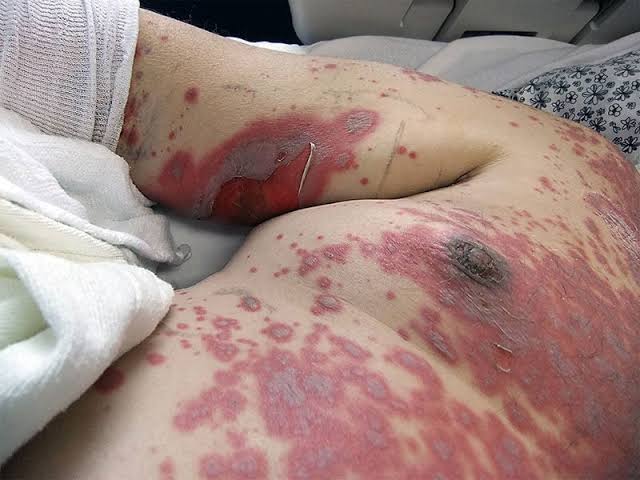Pityriasis rosea;

Overview
Pityriasis rosea, a common skin condition, captivates attention with its distinctive rash pattern and enigmatic etiology.
What is Pityriasis Rosea?
Pityriasis rosea is a self-limiting inflammatory skin disorder characterized by the development of a herald patch, followed by a generalized rash with a distinctive “Christmas tree” distribution pattern. Despite its benign nature, the condition often evokes concern due to its sudden onset and unfamiliar appearance.
Causes of Pityriasis Rosea :
Pityriasis rosea is a common skin condition characterized by the appearance of pink, scaly patches on the body. While the exact cause of pityriasis rosea remains unknown, several factors have been implicated in its development. Understanding these potential causes can provide insights into the mechanisms underlying this dermatological disorder.
Viral Infections
One leading theory suggests that viral infections may play a role in the onset of pityriasis rosea. Research has identified various viruses, including human herpesvirus 6 (HHV-6) and human herpesvirus 7 (HHV-7), as potential triggers for the condition. These viruses are members of the herpesvirus family and are known to cause other skin-related illnesses. It is hypothesized that a viral infection may stimulate an abnormal immune response, leading to the characteristic rash seen in pityriasis rosea.

iS CLINICAL Active Serum; Face Serum, Anti-Aging, Helps skin with acne and pigmentation
Immune Response
The body’s immune system is thought to play a significant role in the development of pityriasis rosea. Some researchers believe that the condition may arise from an exaggerated immune response to a viral or environmental trigger. This immune response can result in inflammation and skin lesions characteristic of pityriasis rosea. However, the specific mechanisms underlying this immune dysregulation remain the subject of ongoing research.
Genetic Predisposition
Genetic factors may also contribute to an individual’s susceptibility to pityriasis rosea. Studies have suggested that certain genetic variations may increase the likelihood of developing the condition. Additionally, a family history of pityriasis rosea or other skin disorders may predispose individuals to the condition. However, more research is needed to elucidate the specific genetic factors involved in the development of pityriasis rosea.
Environmental Triggers
Environmental factors, such as stress, climate, and seasonal changes, have been proposed as potential triggers for pityriasis rosea. Some individuals may experience flare-ups of the condition during periods of increased stress or when exposed to particular environmental conditions. Additionally, changes in temperature and humidity levels may influence the onset and severity of symptoms in susceptible individuals.
Signs and Symptoms:
1. Herald Patch
- Appearance: The condition typically begins with the emergence of a single, large, oval-shaped lesion known as the herald patch.
- Characteristics: This patch is often red, raised, and slightly scaly, resembling a coin or target.
- Location: The herald patch usually appears on the trunk, particularly the chest or back.
- Sensations: It may be accompanied by mild itching or discomfort.
2. Generalized Rash
- Spreading Rash: Following the herald patch, smaller lesions begin to spread in a distinctive pattern resembling the branches of a tree.
- Distribution: These smaller patches, known as secondary or daughter patches, spread symmetrically across the body.
- Appearance: The rash may extend to the neck, arms, and legs, forming a characteristic “Christmas tree” distribution.
- Color and Texture: Individual patches are typically pink or red with well-defined edges and fine scales on the surface.
- Evolution: As the rash progresses, the central portion of the patches may lighten, giving them a salmon-colored appearance.
- Itching: While the rash is generally not painful, some individuals may experience mild itching or irritation.
3. Systemic Symptoms
- Occurrence: In addition to the skin rash, some individuals may experience systemic symptoms.
- Examples: These symptoms may include fatigue, headache, or low-grade fever.
- Severity: Systemic symptoms are typically mild and transient, resolving spontaneously as the rash fades.
Risk Factors:
While pityriasis rosea can affect individuals of any age and ethnicity, certain factors may increase the likelihood of developing the condition. These include:
- Young Age: Pityriasis rosea most commonly occurs in individuals between the ages of 10 and 35, with a peak incidence in the second and third decades of life.
- Seasonal Variation: The condition tends to occur more frequently in the spring and fall months, suggesting a possible association with viral infections or environmental factors.
- Viral Infections: While not conclusively proven, some cases of pityriasis rosea have been linked to preceding viral infections, particularly those caused by human herpesviruses.
Treatment:
In most cases, pityri. rosea resolves spontaneously within 6 to 8 weeks without specific treatment. However, symptomatic relief may be achieved through:
- Topical Steroids: Mild itching associated with the rash can be alleviated with the use of over-the-counter or prescription-strength topical corticosteroids.
- Antihistamines: Oral antihistamines may provide relief from itching, particularly if symptoms are bothersome or disruptive to daily activities.
- Emollients: Moisturizing creams or lotions can help soothe dry, scaly skin and minimize discomfort associated with the rash.
Differential Diagnosis:
Several skin conditions share clinical features with pit. rosea and must be considered in the differential diagnosis, including:
- Tinea corporis (Ringworm): Fungal infection characterized by annular lesions with raised borders and central clearing.
- Secondary Syphilis: Sexually transmitted infection presenting with a diffuse rash, including palms and soles, along with other systemic symptoms.
- Psoriasis: Chronic inflammatory skin disorder characterized by well-demarcated, erythematous plaques covered with silvery scales.
Summary:
Pityriasis rosea, though benign and self-limiting, remains a fascinating dermatological entity, intriguing both clinicians and patients alike. By unraveling its mysteries, from the herald patch to the characteristic Christmas tree distribution of the rash, one gains insight into the captivating nature of this enigmatic skin condition.
Read more:

